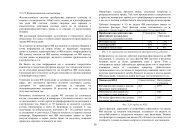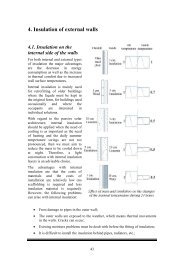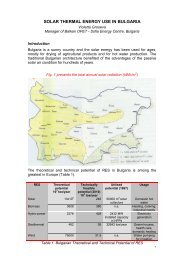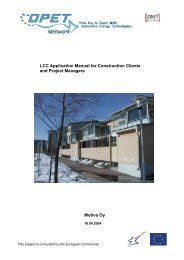Guidebook for Energy Efficiency in Municipalities
Guidebook for Energy Efficiency in Municipalities
Guidebook for Energy Efficiency in Municipalities
You also want an ePaper? Increase the reach of your titles
YUMPU automatically turns print PDFs into web optimized ePapers that Google loves.
money well spent. Structure contracts <strong>for</strong> design and commission<strong>in</strong>g so that part of the<br />
payment depends on the system per<strong>for</strong>m<strong>in</strong>g to specified standards after the build<strong>in</strong>g is<br />
occupied. Designers might also be paid on the basis of system per<strong>for</strong>mance rather than a<br />
percentage of system cost.<br />
In addition, the HVAC designer has to consult with the build<strong>in</strong>g designer to ensure that<br />
peak cool<strong>in</strong>g and heat<strong>in</strong>g loads are m<strong>in</strong>imised through good envelope design. This will<br />
cut the capital cost of the HVAC system, and the peak energy charges.<br />
Build<strong>in</strong>g management systems<br />
Build<strong>in</strong>g management systems (also called build<strong>in</strong>g automation systems or simply BASs)<br />
facilitate control and monitor<strong>in</strong>g of equipment (especially air-condition<strong>in</strong>g and other<br />
mechanical equipment). Such systems can have the advantages of:<br />
improved control, com<strong>for</strong>t and security;<br />
reduced equipment operat<strong>in</strong>g times, energy consumption and GHG emissions, and<br />
reduced wear of the equipment;<br />
improved monitor<strong>in</strong>g of build<strong>in</strong>g and equipment, <strong>in</strong>clud<strong>in</strong>g runn<strong>in</strong>g times, electricity<br />
demand, temperatures, runn<strong>in</strong>g costs, etc.<br />
A BAS will have a capital cost of about € 120 per sensor or controlled po<strong>in</strong>t. The design of<br />
a system (depend<strong>in</strong>g on what the user want it to do now and <strong>in</strong> the future) will require a<br />
significant amount of time spent by staff and/or a consultant. BASs are sometimes<br />
oversold - when they are credited with sav<strong>in</strong>gs that could have been achieved more<br />
economically by fix<strong>in</strong>g exist<strong>in</strong>g simple controls.<br />
When consider<strong>in</strong>g a BAS:<br />
make sure that exist<strong>in</strong>g controls are optimised and that low-cost rectifications are<br />
completed first;<br />
consider what equipment needs controll<strong>in</strong>g and what <strong>in</strong>puts will be used to decide if<br />
and how the equipment will run;<br />
write a technical description of the required BAS (possibly with assistance from <strong>in</strong>house<br />
technical staff or <strong>in</strong>dependent consultant); this will help <strong>in</strong> clarify<strong>in</strong>g the<br />
requirements and communicate them to colleagues and potential suppliers.<br />
When select<strong>in</strong>g a BAS it should be checked:<br />
that the system permits flexibility and later expansion;<br />
what happens to the system if some of the remote equipment fails;<br />
that the system can be easily <strong>in</strong>terrogated and reprogrammed by the organization’s<br />
technical staff/team (without need<strong>in</strong>g to refer to the <strong>in</strong>staller or manufacturer);<br />
that any new software or equipment <strong>in</strong>troduced by the manufacturer will be made<br />
compatible with all previous versions of software and equipment (prevent<strong>in</strong>g<br />
premature obsolescence);<br />
that <strong>in</strong>ternational data <strong>for</strong>mats are supported.<br />
Estimat<strong>in</strong>g energy consumption and greenhouse emissions<br />
Ideally, the energy use <strong>for</strong> HVAC should be separately metered. If this is the case, this<br />
data can be easily converted to GHG emissions. If separate metered data are not<br />
available, ‘house power’ may be separately metered. This <strong>in</strong>cludes HVAC, light<strong>in</strong>g of<br />
common areas, lifts, etc. It may be possible to estimate electricity use <strong>for</strong> activities other<br />
than HVAC, and subtract this from the ‘house power’ to give an estimate of HVAC<br />
consumption. If only the whole build<strong>in</strong>g’s energy use is metered, this at least gives some<br />
<strong>in</strong>dication of HVAC energy consumption.






